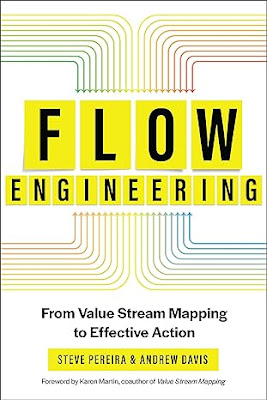If you’re
looking for a way to be able to chip away at this complexity turn to Flow
Engineering: From Value Stream Mapping to Effective Action. Written by Value
Stream Mapping experts Steve Pereira and Andrew Davis, Flow Engineering
provides a step-by-step guide for running fast-paced mapping workshops that
rapidly build shared understanding. Based on foundations from Value Stream
Mapping, cybernetics, and the Toyota Production System, Flow Engineering's
lightweight and iterative practices build the value, clarity, and flow required
for effective collaboration and collective action.
Flow
Engineering is a series of collaborative mapping exercises designed to connect
the dots between an unclear current state and a clear path to a target state.
It’s an open, adaptive, and engaging series of practices that can take you from
complexity to clarity, from friction to flow.
Using the five
key maps to facilitate collaborative “flow conversations,” Pereira and Davis
show how teams can surface tangled process dependencies, conflicting
priorities, and unspoken assumptions that grind progress to a halt. The result?
A clear roadmap owned by the people doing the work to accelerate innovation
cycles, optimize workflows, and achieve more effective coordination.
The book is
organized into 3 parts. The first being gaps that need to be bridged and why
they have been a challenge for most organizations. The second part lays the
foundation for flow engineering with the five mapping steps. The last part
describes approaches to scaling and sustaining your progress with Flow
Engineering beyond an initial pilot. Throughout the book the authors use a
fictional example to help illustrate the practices of Flow Engineering. Each
chapter summarizes key learning points for emphasis.
This book is
for Lean practitioners familiar with the basics of value stream mapping and
basic agile knowledge. Curious problem-solvers struggling to help their teams
or organizations see the big picture will find benefit from the techniques in
Flow Engineering. It’s easy to adapt and tailor to varied situations. It’s
flexible enough to help teams of any skill level, and it’s robust enough to be
used for ambitious process improvements or day-to-day problem-solving.
If you are
looking to improve flow, explore more, or be inspired then consider reading
Flow Engineering.
This book will
be released May 14th but you can preorder here:
Note: The
publisher IT Revolution sent me an advanced copy to review.












